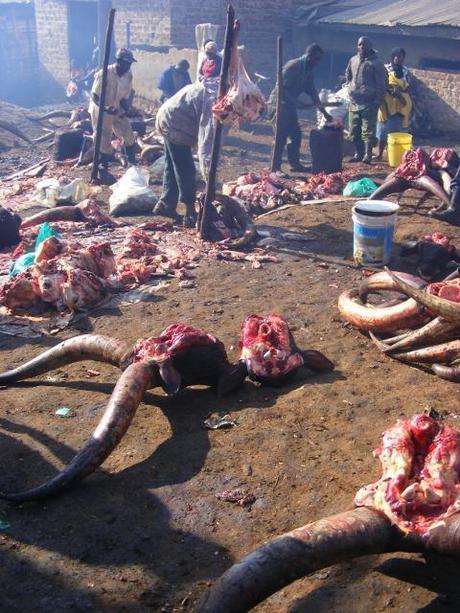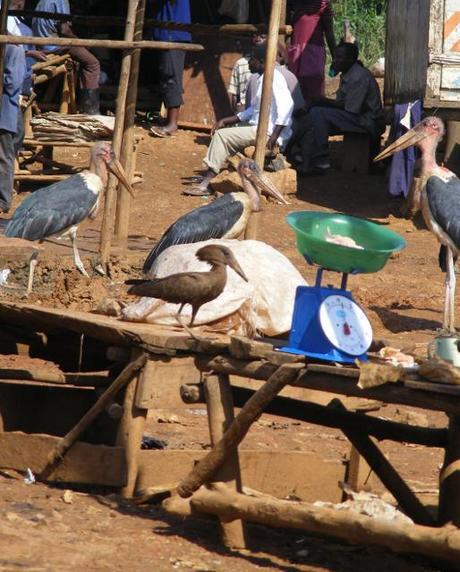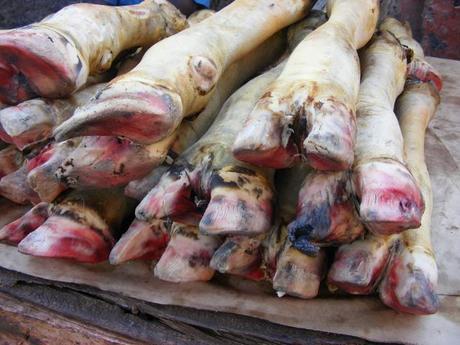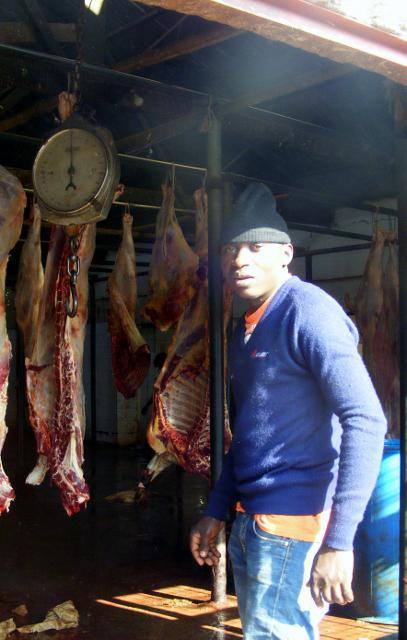Looking for things to do around Kampala? Visiting the abattoir might not be top of every vegetarian’s wish list, but that didn’t stop Alex and I looking forward to the day out at the slaughterhouse, as part of Nature Uganda‘s annual vulture count.

Keeping an eye out for the best titbits, a Marabou Stork sits on the roof of the slaughterhouse
Our gory tour took us to the very smelly outdoor Busega fish factory; the tidy, rustic Kyengera Abattoir and the formidable Kalerwe Abattoir, pictured, on the look-out for Hooded Vultures, Pied Crows, Brown Kites and Marabou Storks.
“I tried not to look at the blood and guts around me and looked down – and narrowly avoided stepping on a cow’s brain!” Not the most glamorous of day’s out for us ladies, tiptoeing around pools of dark red blood seeping into Kalerwe’s thick oozing mud.

My Nature Uganda friend Roger had painted a grim picture of last year's annual vulture count - but I couldn't wait to experience the horror for myself.
Living in Uganda has desensitised me to the horrors of the meat trade. A vegetarian since the age of 13, it was learning about the UK’s concrete and metal ‘factory farms’ that turned me off meat, overnight. In the UK we’re as far removed from the slaughter process as could possibly be (it’s hard to reconcile the surgical cleanliness of the plastic-wrapped portions of meat in the supermarket with the reality of what happens to the animal in the slaughterhouse). Here in Uganda, it’s back to basics: blood, guts and all.

Heaps of body parts whereever we looked in Kalerwe Abattoir, Kampala
So why were we putting ourselves through this?
Vultures aren’t the world’s prettiest birds – that characteristic bald head helps keep the head clean when feeding on a carcass – but they (and the Marabou Storks) are arguably the most useful, and need to be protected.
Populations of the eleven species of African vulture have declined considerably. Threats vary, but include poisoning, loss of habitat loss, and trapping for food and witchcraft.
Vultures are nature’s most successful scavengers. Known by some as ‘Superman of the bird world,’ vultures can eat Anthrax (without dying) and quickly dispose of diseased carcasses (without catching the disease) – and no other animal will eat their carcass.
In the past decade, hundreds of vultures have been accidentally killed across East Africa after consuming poisoned animals set to kill lions and hyenas which had attacked livestock. Vultures are also intentionally poisoned by poachers because the presence of circling vultures alerts wildlife authorities to the location of poachers’ illegal activities.
In a recent incident, 48 vultures were poisoned near the Ishasha River on the Congo border, their bodies found scattered along a path heading back to Queen Elizabeth National Park.
In Kenya, vulture numbers in the Maasai Mara National Reserve have declined by an average of 62% since the 1970s. Vultures have some of the lowest reproductive rates among birds, making them particularly vulnerable. A decade ago none of Kenya’s eight vulture species was on the IUCN Red List of Threatened Species; now 6 out of 8 species are on the Red List, with populations declining at an alarming rate.
Information on Kenyan vultures edited from Summit to save Africa’s vulture populations from extinction on ‘African Raptors‘.

Hammerkop getting in on the act! Huge numbers of Marabou Storks overseeing the fish processing near Natete, Kampala
So how is the demise of this ugly old bird linked to human health?
Following a decimation of the vulture numbers in India, there’s been an increase in disease transmission among dogs and rats. The subsequent increase in dogs and rabies is blamed for an estimated human health costs of $1.5 billion a year. If vulture numbers continue to decline in Kampala, what might be the impact on the residents of the city?

- Too hot to trot! Nothing goes to waste here …
Back at the abattoir, the authorities were suspicious of the muzungu wandering around with a camera – all except this guy:
“You take my picture”

My idea of hell - but just another day at work for this guy
Once beyond the understandably suspicious questions “are you from the Ministry of Health?” people seemed quite interested in what we were doing. Someone offered to feed the birds for us (for a fee). Another guy asked if we could solve the problem of the Marabous shitting on (and therefore destroying) his zinc roof!
At Kyengera, the unmistakable smell of burning flesh led us by the nose down to a shack where a whole cow’s head sat roasting on an open fire. For 500 shillings (the cost of two chapatis) I was invited to take a photo – or (just for laughs!) pose with the man stoking the fire and roasting the head – somehow that just seemed one step too far.
Aren’t you glad I didn’t take that last photo?

